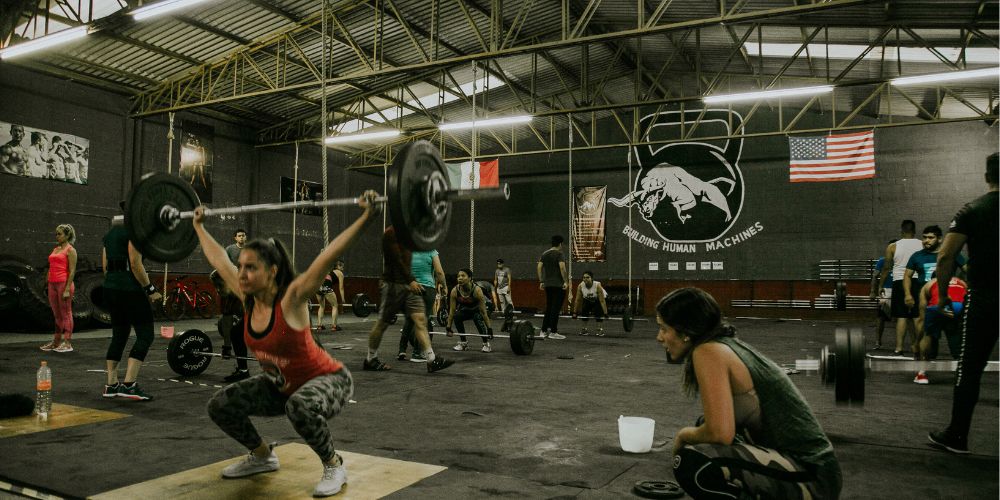As CrossFit has evolved, so has the hyper-muscular physique in the professional men’s and women’s divisions of the Games and other high-level competitions. Does that make CrossFit the new method for building muscle?
CrossFit will build muscle to an extent but will plateau quickly. There are better training options to build muscle, like running a program designed for hypertrophy.
Unfortunately, CrossFit is marred with the brush of illegal substances to obtain their extremely muscular physiques. Does that discount their training methods?
Table of Contents
Does CrossFit Build Muscle?
CrossFit builds muscle, but there are better ways to do it. Resistance training is vital to building muscle since it maximizes mechanical tension, which provides high force generation under stretch [1][2][3]. This means lifting relatively heavy loads through a full range of motion.
Or lifting light loads closer to or to failure. A traditional CrossFit class won’t maximize these hypertrophy factors. A typical class may involve a 5 – 10-minute warm-up, a 20 – 30-minute strength or skill portion, and a 20 – 30-minute workout of the day (WOD) to finish.
While the strength, skill, and WOD portions of the class will involve lifting weights, it’s done with little rest or building to a heavy lift. Neither of these is beneficial for building muscle.
You want to have long rests between sets (2-5 minutes) to lift heavier or, with more effort increasing total volume load.
Outside of this, WODs are typically endurance-based tasks. Endurance exercise, like a CrossFit WOD, signals the AMPK pathway responsible for endurance adaptations [4]. It’s the mTOR pathway that is responsible for stimulating the muscle-building response.
The AMPK inhibits the mTOR pathway, lasts up to 3 hours, and is influenced by the intensity and volume of the WOD [4][5]. Therefore, CrossFit isn’t the best way to approach building muscle.
Is CrossFit Or Gym Training Better For Building Muscle?

Traditional strength and hypertrophy training is better than CrossFit for building muscle. Bodybuilding programs adhere to sound muscle-building principles: varying rep ranges, loads, volume, and longer rest periods.
However, that doesn’t mean someone who practices CrossFit can’t perform bodybuilding training as an accessory. For example, after performing strength or skill work, certain days of the week may involve bodybuilding training for lagging body parts.
These could be the shoulders and triceps for better handstand push-ups or targeting the legs for bigger Olympic lifts.
How Long Does It Take To Build Muscle With CrossFit?
If you don’t come from an active background, you will start to see changes in your body within the first few weeks. You may even look more muscular. Often, this is a reduction of body fat, showing more muscle mass.
Or in the case of being untrained, the muscle can be built from any physical activity, including endurance activity [4].
But building significant muscle is a long-term game. We are talking years, not weeks or months. And with CrossFit not being the best option for building muscle, you’re looking at a longer time frame.
Summary
CrossFit is not a good choice as a muscle-building activity. It doesn’t maximize the mechanisms of hypertrophy where other bodybuilding or physique-style programs do. You can join the Lift Big Eat Big Underground for programs dedicated to building muscle.
References
1. Schoenfeld, B. J. (2010). The mechanisms of muscle hypertrophy and their application to resistance training. The Journal of Strength & Conditioning Research, 24(10), 2857-2872.
2. Wackerhage, H., Schoenfeld, B. J., Hamilton, D. L., Lehti, M., & Hulmi, J. J. (2019). Stimuli and sensors that initiate skeletal muscle hypertrophy following resistance exercise. Journal of applied physiology.
3. Krzysztofik, M., Wilk, M., Wojdała, G., & Gołaś, A. (2019). Maximizing muscle hypertrophy: a systematic review of advanced resistance training techniques and methods. International Journal of environmental research and public health, 16(24), 4897.
4. Methenitis, S. (2018). A brief review on concurrent training: from laboratory to the field. Sports, 6(4), 127.
5. Baar, K. (2014). Using molecular biology to maximize concurrent training. Sports Medicine, 44(2), 117-125.
